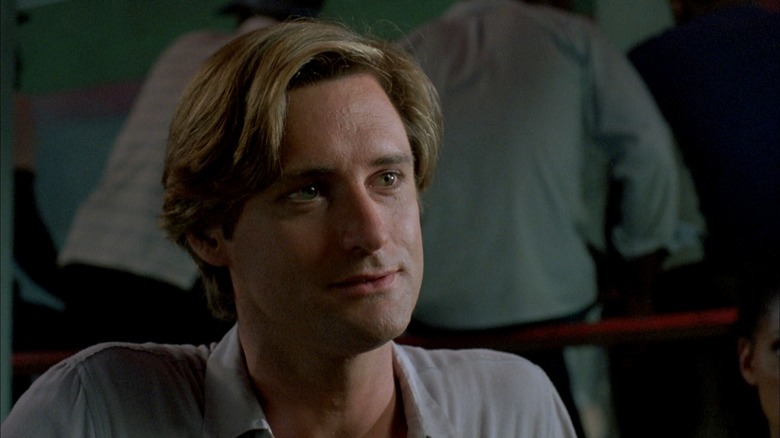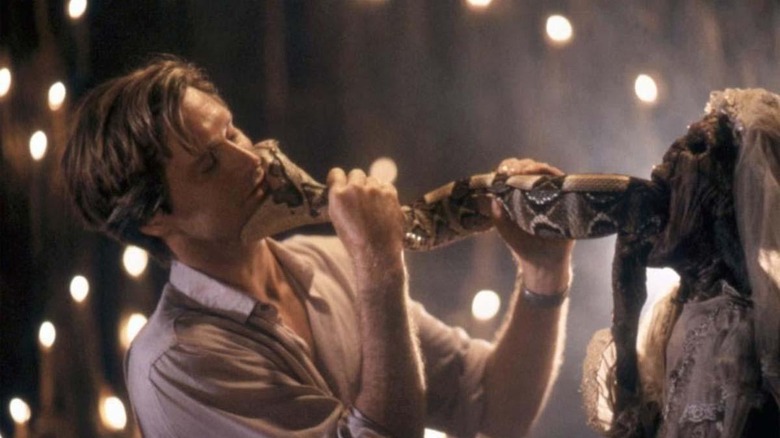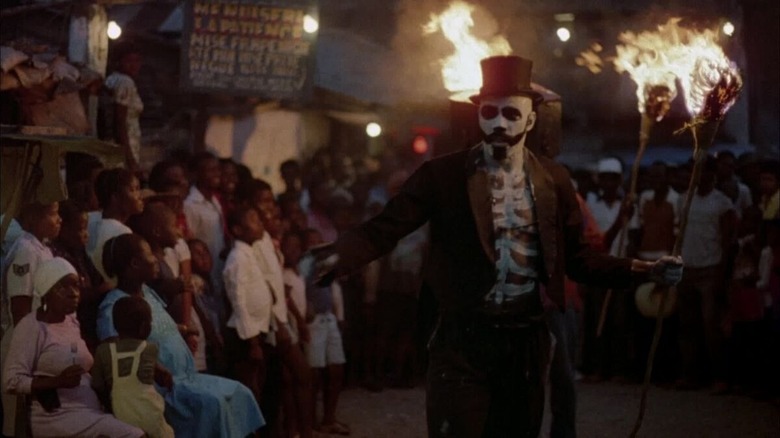Wes Craven's Horror Movie The Serpent And The Rainbow Is Tied To A True Zombie Story
Zombies have become a pretty major part of the horror genre. The first zombie movie, "White Zombie," was released all the way back in 1932, but they first really took a bite out of our subconscious with George Romero's "Night of the Living Dead" in 1968. Since then, their popularity has exploded, with more zombie movies, TV shows, and books than you could shake a stick at. But where did the idea of zombies really come from?
It turns out that zombies have their origins in Haitian Vodou (more commonly known as voodoo). Unlike its cousin hoodoo, practiced in New Orleans as a kind of mixture of folk medicine and superstition, Vodou is a complex diaspora faith borne of West African religions (and, in some regions, Catholic dogma). In Vodou, a zombi is someone put under the control of another through the use of psychedelic plants, a nightmarish concept documented in anthropological texts like "Tell My Horse" by Zora Neale Hurston and "The Serpent and the Rainbow" by Wade Davis. The latter was — you guessed it — turned into a fictionalized film of the same name, directed by horror maestro Wes Craven. That means there are elements of truth in the terrifying movie, but which parts?
The true story behind The Serpent and the Rainbow
The full name of Davis' book is actually "The Serpent and the Rainbow: A Harvard Scientist's Astonishing Journey into the Secret Societies of Haitian Voodoo, Zombies, and Magic," and while it is purported to be a true story, there have been some critics over the years that question its veracity. However, according to Davis, a man named Clairvius Narcisse claimed that he had been turned into a zombie after being fed a local plant that caused him to lose many of his faculties, rendering him a shuffling, obedient, enslaved person. It's terrifying stuff that makes the Hollywoodified hoodoo in movies like "The Skeleton Key" seem sort of silly in comparison, especially because Davis claimed to have found the plant compounds needed to create the coupe poudre to give to a zombie himself, practicing on rats and a monkey.
The powder almost always included the Datura Stramonium plant, and in Davis' animal tests it caused the creatures to be frozen stiff and nearly dead, but they all revived within 24 hours. Further attempts at recreating the experiments were unsuccessful, leading many to wonder if a belief in Vodou creates suggestibility that allows a person to fall into the powder's trance-like state. To this day, the stories of real zombies in Haiti have yet to be fully confirmed or verified, but there are first-hand accounts and even a few photos of alleged zombies. (One of the most famous, in Hurston's "Tell My Horse," is believed to have actually been a very mentally ill woman, but again, it's all still up for debate!)
That voodoo that you (and Wes Craven) do
In the film version of "The Serpent and the Rainbow," anthropologist Dennis Alan (Bill Pullman) is on a mission for a pharmaceutical company to find the Haitian "zombie drug" (the coupe poudre) because they believe it could have commercial use as a potent anesthetic. He ends up diving deep into the world of Vodou, something the locals don't take kindly to, and they try to drive him away with violence and terrifying threats, but he persists. This leads to him eventually being buried alive (with a tarantula for company) just before the film's climax, which is a battle between two different kinds of Vodou magic. Needless to say, Davis likely didn't experience a magic battle between a bokor (a Vodou priest who uses death magic and curses) and an oungan (a Vodou priest who only practices positive magic), but it sure does make for compelling cinema.
There are only a few other movies that deal with Vodou without making it into the silly, commercialized idea of voodoo, though "Angel Heart," "The Devil's Advocate," and "Eve's Bayou" are all pretty excellent and take the subject seriously. There's also the incredible Italian horror flick "Zombi 2," famous for its wooden splinter to the eye scene but deserving of love for its take on the Vodou zombie. "The Serpent and the Rainbow" might not be Craven's most popular movie, but it's still a truly fantastic film that mixes anthropological fact with high-end Hollywood horror.


